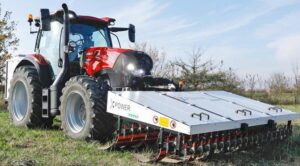The use of chemical herbicides to kill weeds is continuously being questioned in the public eye. Due to legislation changes and rising public pressure, organisations across the globe are looking for sustainable and chemical-free methods to control weeds.
Some of these alternative methods include manual weeding and strimming, as well as thermal weed control methods such as using hot water and steam. However, there are many variables you should look for when deciding which weed control method to switch to, such as efficiency, cost, and the number of treatments required.
Below we’ll dive into exactly how heat kills weeds, the temperature needed to kill weeds, the different methods of thermal weeding, the costs involved with them, and which ones tick off those important key variables.

Can you kill weeds with heat?
Yes, you can kill weeds with heat. There are many thermal methods of weed control which involve wet heat like hot water and steam. Our own Foamstream product makes use of hot water and foam to keep weeds under control. In addition, there are thermal weed control methods that involve dry heat like electricity and flame weeding.
These methods are all designed to heat the vegetative parts of the plant quickly, destroying the surface parts of the weed. Some of the better weed control solutions, such as our own Foamstream also penetrate through to the root and kill the plant entirely providing a much more effective way to kill weeds.
Foamstream is the leading herbicide-free solution for controlling weeds used by councils, cities, and boroughs across the UK and overseas. It combines heat with a biodegradable foam which behaves like a thermal blanket, suffocating the plant and sufficiently killing it.
What temperature is best to kill weeds?
57 degrees Celsius or 135 degrees Fahrenheit.
There’s no doubt that thermal methods are effective and more environmentally friendly than using herbicides or pesticides to control weeds. However, one crucial thing to keep in mind when assessing thermal methods of weed control is to find a solution that holds the weed in the kill zone. The kill zone refers to a temperature of 57 degrees Celsius or 135 degrees Fahrenheit for an extended length of time.
The heat that is delivered has to be kept within this temperature zone so that it can successfully damage the plant’s structure. It also has to enable efficient and effective thermal heat transfer from the leaves to the root. Maintaining this kill zone is a downfall of many of the other, non Foamstream weed control solutions on the market. In other words, they lose heat rapidly which reduces their effectiveness significantly. Steam systems for example kill weeds using saturated steam, which has been heated to over 100 degrees Celsius.
Different methods of thermal weeding and drawbacks
There are many different kinds of thermal weeding methods. While some are entirely safe and environmentally friendly, they may not be quite as efficient when compared to using Foamstream.
Steam weed control
Steam treats weeds because of the high heat level. This high heat level causes the plant's leaf cells to explode, killing the leaves. Due to it being only steam, it is safe to use around animals and people. However, many steam systems rapidly lose heat to the atmosphere.
Due to not being able to keep plants in the kill zone for long enough to have a damaging effect, they require multiple applications across the season. This makes steam both costly, time-intensive and uses the most amount of diesel and water. The rapid heat loss not only impacts the efficiency of this method, but it also means that steam is limited by the type of weather it can be used in. The rapid heat loss means that speed of treatment is very slow.
The Rapid loss of heat that steam experiences was one of the key problems we were trying to solve when we created Foamstream. Our foams heat retention properties allows for the operator to continue treating other weeds while the heat remains under the weed. A faster application speed, less treatment cycles and less consumables are the three key variables contributing to Foamstream far cheaper cost per m2/ sq ft.

Hot water weed control
Moving on from steam, hot water is another form of thermal weed control and it works in a very similar way to steam. Essentially, weeds and unwanted vegetation are killed due to heat exposure. The heat created from the hot water melts the protective coating of the leaf and severely damages the plant’s cellular structure. From here, the weeds are not able to retain moisture and dehydrate within a few hours or days. This method is considered to be easy, economical, and safe.
The main downfall of hot water weed control is the rapid heat loss. The loss of heat means the plant is not kept in the kill zone for long enough for the hot water to be effective. Therefore, it will require many more treatments. Hot water also does not have a great impact on spores and seeds which means future regrowth is not being prevented by this method. Just like steam, hot water is limited by the type of weather it can be used in because of losing its heat so quickly to the atmosphere.

Flame weed control
Flame weeding involves passing an open flame over weeds. The intense high heat causes the cells in the leaf to rupture, resulting in the plant dying. Flame weeding is an old method of weed maintenance and is still used today. It offers visible results not long after treatment and has a relatively cheap initial capital expenditure.
One of the issues with flame-controlling weeds is that the heat burns only the surface vegetation, meaning it is not quite as efficient on the root structure below. Therefore, the weeds are quick to grow back, so more treatments will be required. Besides uncertainty surrounding its efficiency, there are also health and safety concerns around this thermal weed control method which is also very weather dependent.

Electric weed control
Electricity is another thermal weed control method that has gained some traction in recent years, although mostly in an Ag setting. There are two primary kinds of electrical treatment, where both use electric currents to destroy the vital activity of the weeds. Since it boils the root, electricity is seen as rather effective and useful for even spot weeding.
Electric weed control can be a very time-intensive method since a lot of the systems on the market are designed with spot weeding in mind. There are also health and safety concerns around using electricity to eliminate weeds. Current electric weed systems that are on the market recommend cordoning off public access to animals and humans where treatment is taking place to reduce potential risks.
Using electricity to control weeds is seen as quite a popular solution for large-scale agricultural environments, although it is still quite an expensive and very weather-dependent method of weed control.

Summary - is there a method of weed control that is safe and reduces heat loss?
All of the above thermal weeding methods tick off some of the key factors we’ve listed as being important when it comes to keeping weeds under control. However, most of them still have their own drawbacks. Whether it is health and safety-related, being too weather dependent, or due to heat loss that makes them less efficient at killing weeds permanently.
Finding a solution that reduces heat loss and is safe for people, animals, and the planet is key. We’re confident that our Foamstream weed control solution addresses all of these concerns. By combining hot water and biodegradable foam that can be applied using a range of machinery we have developed, the foam creates a thermal blanket which retains heat on the plant.
This means Foamstream can keep weeds in the kill zone for the length of time necessary to penetrate and kill them. This thermal blanket makes Foamstream an incredibly effective eco-friendly method of weed control. Due to its efficiency, it requires fewer treatment cycles compared to any other alternative method on the market. It also sterilises spores and seeds to help reduce future regrowth.

Besides weed control and grounds maintenance, Foamstream can also be used for urban cleaning including graffiti and gum removal. Contact us today if you are interested in learning more about our sustainable weed management technology. We can speak with you more about our products and arrange a demo.


